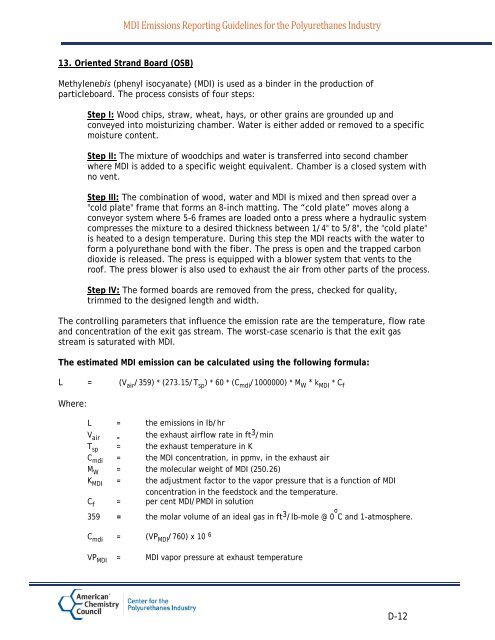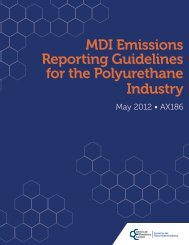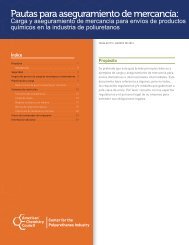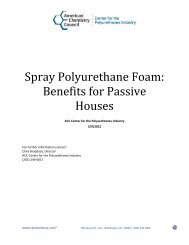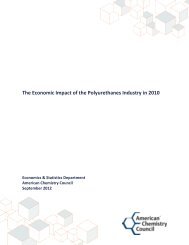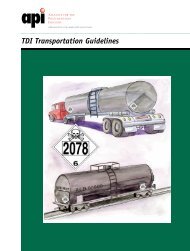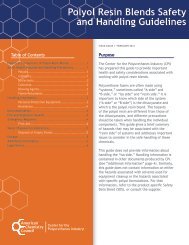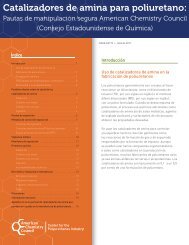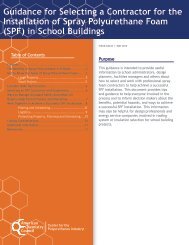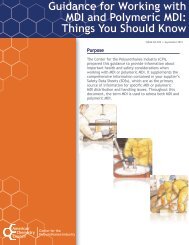MDI Emissions Reporting Guidelines for the ... - Polyurethanes
MDI Emissions Reporting Guidelines for the ... - Polyurethanes
MDI Emissions Reporting Guidelines for the ... - Polyurethanes
You also want an ePaper? Increase the reach of your titles
YUMPU automatically turns print PDFs into web optimized ePapers that Google loves.
<strong>MDI</strong> <strong>Emissions</strong> <strong>Reporting</strong> <strong>Guidelines</strong> <strong>for</strong> <strong>the</strong> <strong>Polyurethanes</strong> Industry<br />
13. Oriented Strand Board (OSB)<br />
Methylenebis (phenyl isocyanate) (<strong>MDI</strong>) is used as a binder in <strong>the</strong> production of<br />
particleboard. The process consists of four steps:<br />
Step I: Wood chips, straw, wheat, hays, or o<strong>the</strong>r grains are grounded up and<br />
conveyed into moisturizing chamber. Water is ei<strong>the</strong>r added or removed to a specific<br />
moisture content.<br />
Step II: The mixture of woodchips and water is transferred into second chamber<br />
where <strong>MDI</strong> is added to a specific weight equivalent. Chamber is a closed system with<br />
no vent.<br />
Step III: The combination of wood, water and <strong>MDI</strong> is mixed and <strong>the</strong>n spread over a<br />
"cold plate" frame that <strong>for</strong>ms an 8-inch matting. The “cold plate” moves along a<br />
conveyor system where 5-6 frames are loaded onto a press where a hydraulic system<br />
compresses <strong>the</strong> mixture to a desired thickness between 1/4" to 5/8", <strong>the</strong> "cold plate"<br />
is heated to a design temperature. During this step <strong>the</strong> <strong>MDI</strong> reacts with <strong>the</strong> water to<br />
<strong>for</strong>m a polyurethane bond with <strong>the</strong> fiber. The press is open and <strong>the</strong> trapped carbon<br />
dioxide is released. The press is equipped with a blower system that vents to <strong>the</strong><br />
roof. The press blower is also used to exhaust <strong>the</strong> air from o<strong>the</strong>r parts of <strong>the</strong> process.<br />
Step IV: The <strong>for</strong>med boards are removed from <strong>the</strong> press, checked <strong>for</strong> quality,<br />
trimmed to <strong>the</strong> designed length and width.<br />
The controlling parameters that influence <strong>the</strong> emission rate are <strong>the</strong> temperature, flow rate<br />
and concentration of <strong>the</strong> exit gas stream. The worst-case scenario is that <strong>the</strong> exit gas<br />
stream is saturated with <strong>MDI</strong>.<br />
The estimated <strong>MDI</strong> emission can be calculated using <strong>the</strong> following <strong>for</strong>mula:<br />
L = (V air /359) * (273.15/T sp ) * 60 * (C mdi /1000000) * M W * k <strong>MDI</strong> * C f<br />
Where:<br />
L = <strong>the</strong> emissions in lb/hr<br />
Vair = <strong>the</strong> exhaust airflow rate in ft3 /min<br />
Tsp = <strong>the</strong> exhaust temperature in K<br />
Cmdi = <strong>the</strong> <strong>MDI</strong> concentration, in ppmv, in <strong>the</strong> exhaust air<br />
MW = <strong>the</strong> molecular weight of <strong>MDI</strong> (250.26)<br />
K<strong>MDI</strong> = <strong>the</strong> adjustment factor to <strong>the</strong> vapor pressure that is a function of <strong>MDI</strong><br />
concentration in <strong>the</strong> feedstock and <strong>the</strong> temperature.<br />
Cf = per cent <strong>MDI</strong>/P<strong>MDI</strong> in solution<br />
359 = <strong>the</strong> molar volume of an ideal gas in ft3 /lb-mole @ 0 o<br />
C and 1-atmosphere.<br />
C mdi = (VP <strong>MDI</strong> /760) x 10 6<br />
VP <strong>MDI</strong> = <strong>MDI</strong> vapor pressure at exhaust temperature<br />
D-12


